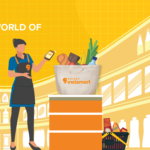Falafel is more than just a beloved street food; it’s a culinary icon with a history as rich as its flavor. These golden, crispy balls or patties, typically made from ground chickpeas or fava beans mixed with fragrant herbs and spices, are enjoyed by millions worldwide. While the snack is commonly associated with Middle Eastern cuisine, its influence transcends borders, symbolizing comfort, tradition, and shared heritage.
Whether stuffed into warm pita bread, topped with fresh salad, or drizzled with creamy tahini sauce, it is a versatile dish that satisfies both the palate and the soul. Its appeal lies in its simplicity, yet it carries a deep, complex history. Let’s dive into the journey of falafel, from its origins in ancient Egypt to its global fame.
From Egypt to the Middle East: The Ancient History of Falafel Origin
Falafel’s Beginnings in Egypt

The history of falafel begins in Egypt, where it is believed to have originated as a vegetarian alternative to meat. Known locally as ta’amiya, falafel was crafted from fava beans, a staple in Egyptian cuisine. Its creation is often linked to early Christian Copts, who needed a meat-free dish to consume during periods of religious fasting, particularly Lent. These deep-fried fava bean patties became a source of sustenance and a testament to culinary ingenuity.
How Falafel Spread Across the Middle East

As the snack gained popularity in Egypt, its recipe began to evolve and adapt as it spread to neighboring regions. When it reached the Levant—comprising countries like Lebanon, Syria, Jordan, and Palestine—chickpeas replaced fava beans as the primary ingredient. This substitution not only altered the texture and flavor but also created a unique version that is now widely recognized.
The portability and affordability of the dish made it a favorite among merchants and travelers, contributing to its rapid dissemination. It became a symbol of Middle Eastern street food culture, celebrated for its ability to bring communities together over shared flavors and traditions.
Global Ascent After Falafel Origin: From Middle Eastern Staple to Worldwide Sensation

The Role of Diaspora Communities
The snack’s journey beyond the Middle East began with diaspora communities, who carried their culinary traditions with them as they settled in Europe, North America, and other parts of the world. Middle Eastern immigrants introduced it to new audiences, often selling it at food markets, festivals, and small eateries. Its plant-based ingredients resonated with vegetarian and vegan communities, further propelling its popularity.
A Global Street Food Phenomenon
In recent decades, it has transcended its Middle Eastern roots to become a global phenomenon. It’s now a staple in urban food scenes, from New York to Berlin to Mumbai. Fusion versions such as those stuffed with cheese or spiced with chili flakes, cater to local tastes, showcasing its versatility.
The rise to global fame also coincided with the growing demand for plant-based diets and sustainable food options. As a protein-packed, meat-free dish, the snack appeals to health-conscious eaters and those seeking eco-friendly meal choices. Restaurants and food trucks worldwide have embraced it as a flavorful, filling, and adaptable menu item.
Variations and Modern Adaptations of Falafel
Traditional Falafel
Traditional falafel recipes feature a blend of ground chickpeas or fava beans, onions, garlic, fresh herbs like parsley and cilantro, and spices such as cumin and coriander. The mixture is shaped into balls or patties, then deep-fried to golden perfection.
Fusion and Creative Twists
In addition to classic versions, chefs around the globe have reimagined the dish with modern twists:
- Stuffed Falafel: Filled with ingredients like cheese, olives, or caramelized onions.
- Baked Falafel: A healthier alternative to the traditional deep-fried version.
- Colorful Falafel: Made with beets, sweet potatoes, or spinach for added flavor and visual appeal.
Order Falafel Online from Swiggy
Craving a plate of authentic falafel but don’t have the time or energy to cook? Swiggy has you covered! With just a few taps on your phone, you can enjoy the crispy, golden goodness of falafel delivered straight to your doorstep. Whether you’re in the mood for traditional balls served with tahini sauce or creative variations like stuffed or baked options, Swiggy connects you with the best eateries in your city. Order food online from local restaurants specializing in Middle Eastern cuisine or international chains offering their unique takes on this timeless classic.
Swiggy makes it easy to indulge in your cravings, whether you’re planning a quick lunch, a family dinner, or a late-night snack. With their reliable delivery service and a plethora of options, enjoying authentic falafel has never been more convenient. So why wait? Place your order now and experience the magic of the dish without stepping into the kitchen.
Conclusion
Falafel’s journey from the ancient kitchens of Egypt to its status as a global culinary icon is nothing short of extraordinary. Its timeless appeal lies in its simplicity, versatility, and rich cultural heritage. From its humble beginnings as a meat substitute during religious fasting to its current position as a beloved street food worldwide, the snack has evolved while maintaining its core identity.
Today, it is more than just a dish; it’s a symbol of shared traditions and a testament to the power of food in bringing people together. Whether you prefer the classic recipe or modern twists, falafel offers something for everyone. Its crispy exterior, flavorful interior, and aromatic spices continue to captivate taste buds across generations and geographies.
So the next time you bite into a piece, take a moment to appreciate the history, artistry, and love that goes into this Middle Eastern classic. Whether you’re savoring it at a bustling market, a cozy restaurant, or the comfort of your home through Swiggy, the snack remains a culinary treasure that transcends time and place.
FAQ
1. What is the origin country of falafel?
Falafel country origin is believed to be Egypt, where it was initially made with fava beans and known as ta’amiya.
2. What is falafel made of?
It is traditionally made from ground chickpeas or fava beans, mixed with onions, garlic, herbs, and spices, and then deep-fried into crispy balls or patties.
3. Is falafel healthy?
Yes, it can be a healthy option, as it is high in protein, fiber, and essential nutrients. Opting for baked version instead of deep-fried can further enhance its health benefits.
Author Bio
Satisfying your cravings, one bite at a time. Discover the best eats, trends, and uncover the hidden gems with us to make your online ordering or dining experience a memorable one.
















































































